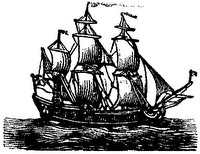John Adams's Tale of the "Irish Infant"
 As John Adams described it in his Autobiography, the man who convinced him to defend the soldiers after the Boston Massacre was “Mr. Forrest...who was then called the Irish Infant.” Who was this man, and what did he say about the case?
As John Adams described it in his Autobiography, the man who convinced him to defend the soldiers after the Boston Massacre was “Mr. Forrest...who was then called the Irish Infant.” Who was this man, and what did he say about the case?
James Forrest was a merchant from Ireland who brought his family to Boston in 1761. Like most (but not all) recent immigrants to Massachusetts, he sided with the royal government rather than the Whigs during the political disputes of the following years.
In October 1768, after four army regiments arrived in Boston, newspapers reported, “Mr. Forrest from Ireland had let them a house lately purchased for about £50 sterling, at the rate of £60 sterling per annum.” The army was still using this building in “New Boston” (also called West Boston or, later, the West End) for a barracks in 1770.
Forrest was at the British Coffee-House on 5 Sept 1769 when James Otis, Jr., and Customs Commissioner John Robinson had their fight. He was there again on the night of 5 March with a captain from the 29th regiment. On hearing the fire alarm, the men went up to the roof and saw the shootings on King Street from above.
According to Adams, the next morning Forrest came to him in tears, desperately seeking a lawyer to represent the army captain accused of murder after those shootings. Adams said Forrest was known around town as the “Irish Infant,” possibly because he cried a lot, but I haven’t found any independent confirmation of that nickname or the lachrymose tendency.
Forrest remained loyal to the British government. In December 1775, during the siege of Boston, he organized a militia company called the Loyal Irish Volunteers. It never saw a battle, however, and might simply have helped patrol the town or given its genteel members a way to keep busy that winter. Forrest evacuated Boston with the British army in March 1776. The Massachusetts government banned him from returning two years later, along with many other prominent Crown appointees and supporters.
At the end of the war, the British government formed a “Royal Commission on the Losses and Services of American Loyalists” to compensate subjects who had remained loyal to the Crown. Claimants had to submit evidence of their “losses and services” in the form of sworn statements and testimonials from officials and other people. These documents are filed in the U.K.’s National Archives (formerly the Public Records Office), and they’ve been the basis of many books and studies.
According to Hiller B. Zobel’s The Boston Massacre, Forrest submitted a stack of documents to support his claim to have been an energetic servant of the king. However, he didn’t write a word about finding legal counsel for Capt. Preston in 1770. Neither did his character witnesses, including Gen. Thomas Gage. Other Loyalists mentioned the Massacre case and their roles in the trial, so there was no reason for Forrest to leave it out.
Furthermore, no one before John Adams in 1802 connected Forrest to the Massacre trial. Josiah Quincy, Jr., was evidently approached by an army sergeant, not a merchant. Lt. Gov. Thomas Hutchinson sent detailed reports on the situation to London, mentioning several men as helpful but not Forrest. So the "Irish Infant" offers no corroboration for Adams's memory, and some additional questions.
TOMORROW: How Adams's perception evolved over time.

3 comments:
Hi, Mr Bell. I have found a Captain Forrest who was the head of a ship HMS Wager, whose crew was accused of murdering two men in Boston, in an effort to impress them in 1745. Could this be the same Capt Forrest?
The Royal Navy captain Arthur Forrest was in the West Indies in early 1770. In addition, Adams would have referred to him by his rank, not as “Mr. Forrest.” So while I appreciate the effort to explain the discrepancies of this story, I don’t think that’s the right lead.
The Adams Papers editors have detected other ways that Adams’s reminiscence about how he defended Capt. Preston and the soldiers doesn’t square with the documentary record.
Post a Comment